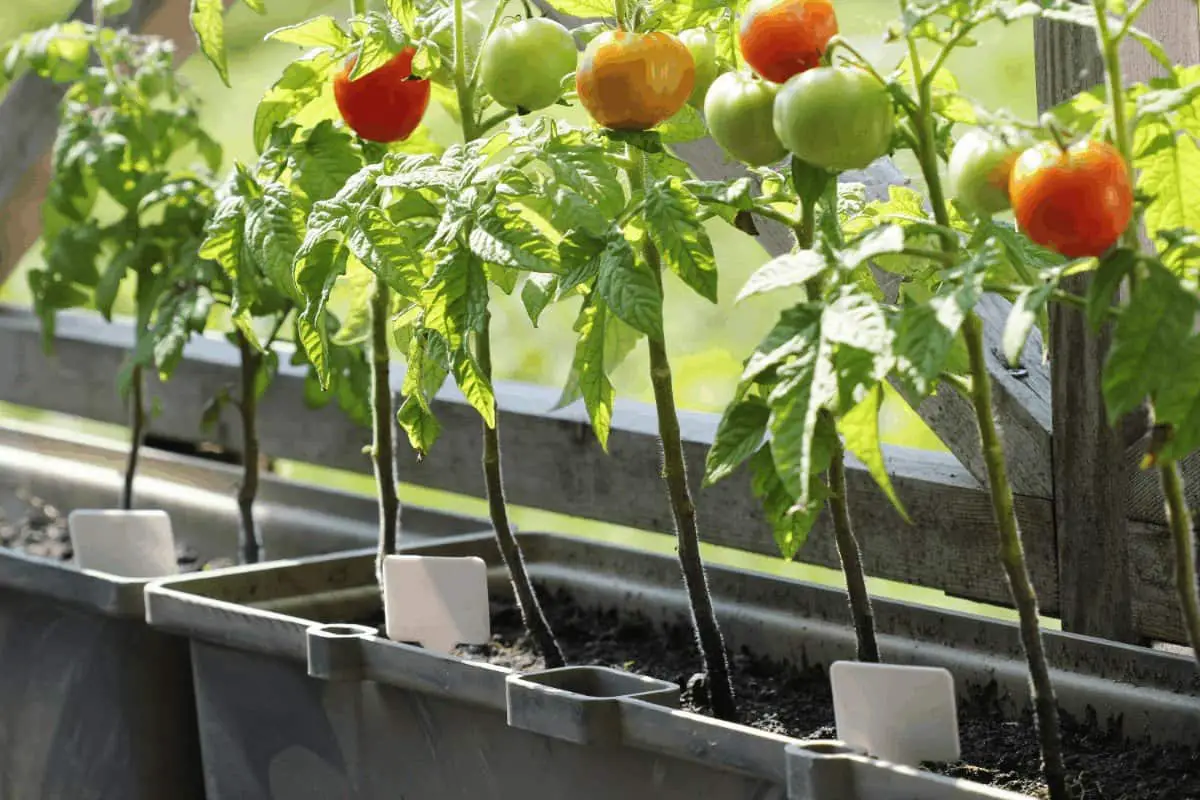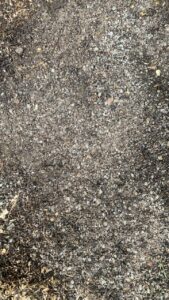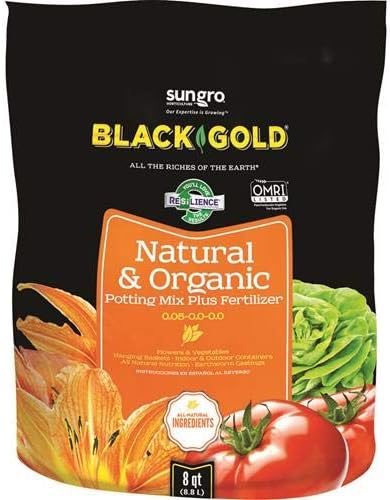Last Updated on February 13, 2023 by Tony Manhart
Is peat moss good for tomatoes? Yes. Should you use it for tomato potting soil? No. Read on to find out why producing tomatoes is better done without peat moss, and how to produce the best-tasting, firm, sweet, delicious tomatoes.
A Quick Overview of Tomatoes
The Tomato, Solanum lycopersicum, is a fruit that is also used as a vegetable. For me, this is one of the must-grow crops for every year, because a tomato grown in your own garden, in the best soil, given love and care, and eaten right off the vine tastes better than any tomato you can buy.
We get two types of tomatoes based on growth style. Determinate tomatoes grow to a specific size, flower, fruit, and die. Indeterminate tomatoes grow a bit, flower and fruit a bit, and grow some more and eventually take over your garden and life giving you more fruit than you can even give away.
There are many different types of tomatoes – called cultivars. These range from really big beefsteak-type tomatoes to minute cherry tomatoes. There is a tomato out there for nearly every use! There is even a cultivar that is good for throwing at people called the Granny’s Throwing Tomato.
How to Choose The Best Soil for Tomatoes
Tomatoes thrive in compost and nutrient-rich soil. In fact, you can grow them in straight compost and they will do fine. They prefer a soil that is slightly acidic. The soil should be loose, and drain well – it should retain moisture, but not be sticky wet. Tomatoes grow fast, and when they get going, they suck water up at an incredible rate, hence the soil needs to be able to hold enough for the plants to grow fast.
The Ideal Tomato Soil pH
Tomato soil needs to be slightly acidic. Most compost has a pH that is around neutral, hence we need to drop the soil pH ever so slightly. Let us look at a few tricks people use to achieve this.
Lowering pH – Is Peat Moss Good for Tomatoes?
Peat moss can allow you to take a compost mix that has a higher pH and lower it -this is because many peat moss preparations have a pH that is in the 3-4 range. In this regard, mixing a bit of peat moss into your tomato mix definitely helps you get the pH down – however, the reason we garden is to produce healthy food – if we kill the planet in the process, this is not healthy.
Peat moss is mined in Canada and Russia, with a little bit from Scandinavia and a few other places. The moss layer is entirely unsustainably harvested, and the environmental impact of this mining is significant. If you have a conscience and care about the ecosystems that help to keep your planet going, and your air breathable, there are better things to use than peat moss! So yes peat moss is good for tomatoes – but it is not good for you, or your offspring if you plan to live on this planet for long. If you want to read more, here are the headline issues summarised from a few peer-reviewed papers.
Lowering pH – the Sustainable Right Way
If you need to lower the pH of soil for tomatoes I generally advise using a soil mix that is rich in compost. Generally, compost has a pH range that is nearly right for tomatoes – and adding a cup of pine bark per gallon of soil will get it into the right range if it is a bit out. Pine bark is generally harvested from trees that are grown according to the Forestry Stewardship Council sustainability guidelines. This means that if you have to adjust the pH down a little bit and choose pine bark, you are choosing a soil amendment that is sustainable. I have some very successful friends in the industrial berry and cannabis industry who are leading this crusade away from using peat moss – it is just not the right material given its terrible impact on our world. Even if pine bark is slightly inferior to peat moss, it is way superior in the long term.
The Best Dirt for Tomatoes
People commonly ask what is the best dirt for tomatoes. This is actually a very pertinent question, and I can say that I discovered the answer to this by mistake. If you collect the sand/gravel that washes along ditches next to a suburban road (one that does not have a lot of traffic), this “dirt” is the perfect “soil” inclusion for growing tomatoes (now that fuel is unleaded). This “dirt” comprises topsoil that washes off lawns on the verges during rain, some organic matter, litter (remove), and gravel. Road gravel is typically made from milled basal or sandstone – both of these are rich sources of micronutrients for soil. There are in fact commercial powdered rock products that are sold as micronutrient supplements such as this.
I collect this roadside gravel/sand/topsoil mix and store it in buckets. When I mix tomato soil, I use it as described in the next sections.
Mixing Your own Tomato Potting Soil
If you have access to compost, and the dirt mentioned above, you can make a very good tomato mix. I tend to adlib these so I get the mix with the right feel – but if you have manure, compost, and some sandy grit you can mix these together. When the mixture is completely mixed it should have at least 10% grit and a mix of 30% manure and the rest compost. Take that volume when complete, and add at least 10%-20% by volume pearlite to it. Pearlite makes a big difference to the way the soil works in terms of allowing air in and out of the soil, and also in terms of making sure the soil does not get waterlogged. Pearlite is always a good investment. It just makes the soil better. If you are worried about pH you can add some pine bark as well. For me, my compost is acidic enough and I get very good results with this mix.
Mixing the Best Soil for Tomatoes in Grow Bags
A grow bag is slightly different from a pot in that the entire surface of the grow bag is in contact with the atmosphere – this means that water evaporates from the surface. If you look at the surface area that is now losing moisture compared to a pot, this grow bag has a far greater ability to dry out. In this regard, for soil for a grow bag, you can use a similar mix to that above, but incorporate a bit of hydrated coco coir. 10-15% of the volume of the mix should be enough to hold a bit of moisture in the soil. I have a love-hate relationship with coco-coir (and grow bags) – it is an amazing product, but it also is inert – it does very little for your soil. Do not add too much.
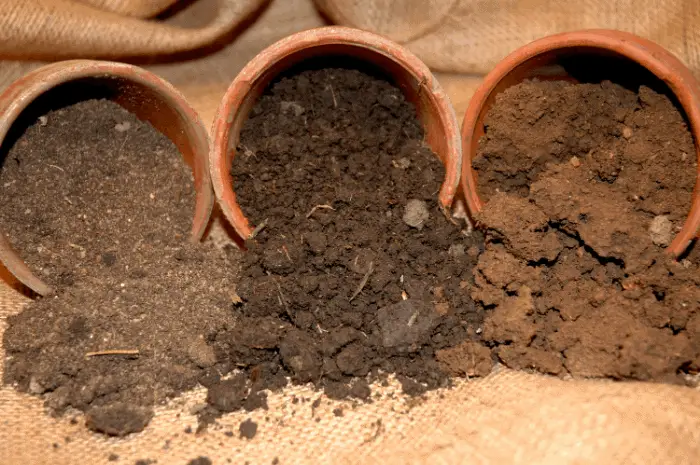
What if You Do Not Have Your Own Ingredients to Make Soil?
Luckily your solutions are a mere click away. A wide range of good-quality soils is available for purchase online. You may also find soil at your local nursery. Here is a list of a few decent soils that will give you good results. I am remarkably disappointed to see that all of these companies, that promote their “organic” nature, are using peat moss!! This is completely disingenuous and we need to put pressure on them to be a bit more environmentally conscious.
Recommended Soil for Tomatoes
1. Black Gold All Organic Potting Soil
- Made in the United States
- 8-Quart
- Loamy rich soil
- It contains perlite and pumice for good drainage
- For tomatoes and other vegetables
- Use it to start seedlings, to transplant or grow from the stem
- Other ingredients: Canadian Sphagnum Peat Moss, Composted or Aged Bark, Compost, Earthworm Castings, Horticultural Grade Perlite, Pumice, or Cinders, Organic Grade Fertilizer
2. Perfect Plants Organic Potting Mix
- 8-Quart
- For indoor and outdoor fruits and vegetables
- You can use it in potted tomatoes
- It contains perlite, coconut coir, and peat moss for good drainage, moisture retention, and water absorption
- It contains Mycorrhizae: is a plant-healthy fungus that enhances nutrition levels in the soil without artificial fertilizers.
- Other ingredients: Mycorrhizae, Worm Castings, and Composted Pine Bark with added Lime for the perfect pH balance.
3. Foxfarm Ocean Forest Organic Potting Soil Mix
- 12-Quart
- pH adjusted at 6.3 to 6.8 to allow for optimum fertilizer uptake
- Recommended for potted tomatoes plants.
- There’s no need for nitrogen fertilizers at first, after 2 weeks you will need to add fertilizer.
- Composted forest humus, sandy loam, and sphagnum peat moss for good aeration and drainage.
- It contains earthworm castings, bat guano, and Pacific Northwest sea-going fish, crab meal, composted forest humus, sandy loam, and sphagnum peat moss.
Where to Plant Your Tomatoes
If you use soil for a pot, or gro-bag and grow tomatoes in it, it is a good idea to move this soil to a different use the next year. Tomatoes are disease magnets, and fungal, viral, and other pests build up in the soil. By growing in the same soil for multiple seasons, you can accumulate pests. Generally, cycle your soil to another use after you have grown tomatoes. I find spent tomato soil does very well as carrot and radish soil in the next year. Mix a bit of wood ash into the soil, and it makes perfect potassium-rich carrot soil.
Sunshine
Although sunlight doesn’t really affect the soil, remember to plant tomatoes in a location where they will get at least 8 hours of full sunshine a day. These glorious red fruits desperately enjoy sunbathing and won’t grow properly without abundant sunlight.
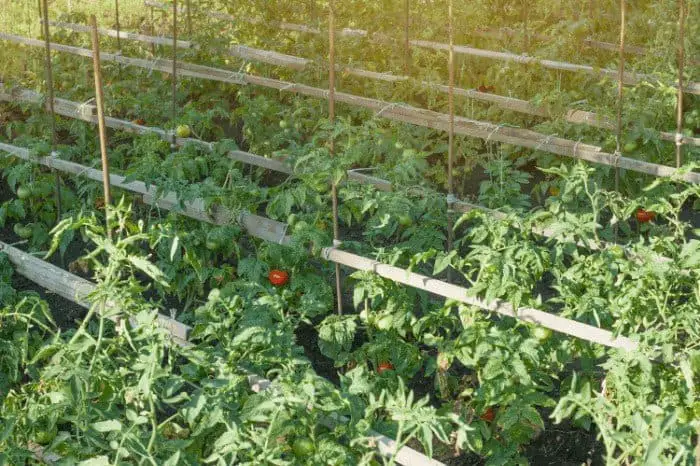
The only catch to sunshine is that the sun around noon might be too intense for the plants. Many growers either place strategic cloths as protection or otherwise plant sunflowers that will be in full bloom and defend the fresh tomatoes from much of the sun’s harsh rays. If you can, try to plot out your garden before you start cultivating and try to figure out when shade appears and from what direction. It can save you a lot of trouble in the long run.
Supplemental Feeding for Tomatoes in Pots
A pot is a limited volume of soil – tomatoes can deplete the nutrients available quite quickly. Using some sort of slow-release organic fertilizer will help – you can add some of this from time to time as per the recommendations to keep your plants healthy. Mix a bit into the soil for the next year, and when you plant your carrots in the soil, this will be ready and healthy soil again.
Conclusion – The Best Potting Mix for Tomatoes
Is peat moss good for tomatoes? Yes. But we now know that we should really put pressure on companies that provide products with this unsustainable resource in them to stop. You can mix your own soils, using pine bark to get the pH right, lots of compost, sand, and gravel sustainably harvested from road gutters, and pearlite. If you are going to use gro-bags add a bit of coco-coir. Use supplemental organic fertilizer and you will produce amazing-tasting tomatoes! Remember, the more organic the soil, and the broader the range of nutrients in the soil, the better your plants will taste. There is no point in producing tomatoes that taste like bland shop tomatoes, so invest in making good soil, and produce exceptional tomatoes!
FAQs
What soil do tomatoes like best?
Soil is the most fundamental part of a plant’s life, so it is important to know what kind of soil do tomatoes like best.
Tomato plants need good drainage, aeration, and a level topsoil with a pH value of 6.5 or higher. The pH value can be adjusted through the addition of organic material such as compost, peat moss and leaf mold.
Tomatoes like to grow best in a sunny, well-drained spot and a pH of 6.5. They also need full sun, good air circulation and some organic matter in their soil to grow well.
What should I add to my soil before planting tomatoes?
The only requirement is that it should be an organic matter like compost or peat moss that will stick to the roots of the plant. The key ingredients for a tomato’s roots are humus and potassium nitrate (KNO3).
It’s always a good idea to start off with clean soil since tomatoes require a lot of nutrients that can get damaged by poor quality soils. You might need more nutrients if your tomato plants grow slowly or show signs of disease and lack in vigor.
One way to maintain your plants is by using a balanced fertilizer such as compost, which has high nitrogen content. Avoid using too much phosphorous as it can lead to uneven production of leaves and stems on your tomato plants. You can also use an irrigation system with a reservoir that releases water only when needed.
What is best compost for tomatoes?
There are many compost types that can be used for a variety of plants. Wood chips are the best option for tomatoes because they help create the ideal conditions for healthy soil and strong plant growth. Wood chips also provide moisture retention and because of their high carbon content they help create a fertile soil.
Best compost for tomatoes usually has more nitrogen and less carbon than other types of composts. Some people also recommend adding blood meal, bone meal, and chicken manure to your compost as this will provide more nutrients than other ingredients.
What do you put around tomato plants?
When plants are in the ground, they need certain things around them so that they can grow well.
The best thing to put around tomatoes is a tomato cage. These cages are made of metal or plastic and help keep plants upright so that they can grow without being pulled over by the weight of fruit.
Is peat moss a good mulch for tomatoes?
Peat moss has a lot of benefits for the garden. It is a renewable resource and it doesn't affect soil pH levels. But it can be difficult to work with, and it doesn't provide much in terms of weed control.
Peat moss is a good mulch for tomatoes but there are some drawbacks that you should be aware of before using peat moss in your garden. The main downside to using this type of mulch is that the moss tends to clump and stick together when wet, making it hard to spread evenly in your garden bed. This means you need to make sure you water the peat thoroughly before spreading or else you'll end up with large patches without any mulch at all.
Dr. Garth A. Cambray is a Canadian/South African entrepreneur and beekeeper with 28 years of experience in apiculture and specializes in adding value to honey. His Ph.D. research developed a new advanced continuous fermentation method for making mead that has resulted in a number of companies globally being able to access markets for mead. His company, Makana Meadery, exports honey mead to the USA where it is available to discerning connoisseurs. He has also developed technologies to commercially manufacture organic honey vinegar in Zambia for export globally. He holds a few patents globally in the ethanol industry and believes in technology and knowledge transfer for human development and environmental sustainability. One of his proudest achievements is the fact that the wind farm he started at one of his old apiary sites has essentially made his hometown carbon neutral.

